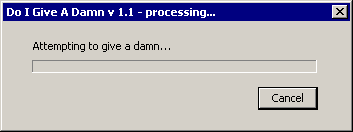
• Introduction
• Index
• Colophon
Email us,
as long as it’s not to tell us you’re
offended ... we couldn’t possibly care less
Periodic surliness courtesy of our
RSS feed
(this is Abuse,
Arguments is down the hall).
Try some of the other ways to view this web site. Each of the
following links will display the site with a different motif.
• Default
• Index
• Circa 1993
• DamnDirtyRINO.com
• Definition
• Quotations
• Neal Boortz
• Libertarian Party
• Church of FSM
• NutDriver Racing
• ShootingShark
• Pair Networks
• PairNIC
• Blosxom

Colophon
I have tried to implement this ’blog in such a way that any
browser can successfully render it legibly in virtually all common
circumstances, and that it will conform to the sizes you have set for
text. To that end, I have provided several “Themes” that
you can choose to give different “looks” for the pages.
The menu bar on the left of the pages provides links to these
“Themes” so that you can try them out.
The pages also specify sizes as percentages. For example, the width of a cell in a table might be specified as “15%” rather than “150px” (150 pixels). This allows the pages to adapt more cleanly to differing screen resolutions, user-selected fonts, window sizes, and the like.
Finally, the pages request specific typefaces, but also provide reasonable alternatives for users that do not have those typefaces installed. If none of the requested typefaces exist on your machine, the browser will render the pages using the default typefaces you set for your browser. The following sections discuss the typefaces in more detail.
The place that this site design may cause you trouble is with the colors. At the moment, the styling of this site forces the text and background colors into a specific palette. If you have problems with color perception, this might interfere with your ability to use the site. To reduce the effect of this, I provide several different themes for the site that you can select dynamically. Hopefully one of them will suit your needs if the default one doesn’t. In particular, try the “Circa 1993” (low tech) version.
1. Headline Typeface
The ’blog uses a typeface named “Impact” for its logo, headings, and titles, as a first preference. If “Impact” is not available, the blog will try to use “Arial Black”. If neither of these is available, it will use the default sans serif font configured for your browser.
Designed in 1965 by Geoffrey Lee for the Stephenson Blake type foundry, “Impact” is a very heavy, almost black sans serif typeface. Its strongly condensed glyphs have more contrast between thick strokes and thin than many typefaces. Useless as a body typeface, it can provide dramatic impact when used for headings, even though most catalogs classify it as a “fantasy” typeface.
Unfortunately, “Impact” is a commercial typeface that is not freely distributable. On the other hand, it is a very common typeface on both Windows and Mac platforms, and fairly common on Unix-based platforms.
At one time, Microsoft distributed a licensed TrueType version of this typeface as part of its Microsoft Core Fonts. They also included it with numerous versions of Word™ and other products. Though they do not freely distribute this typeface anymore, it is available widely on the Internet. It also featured in the core system fonts of some versions of Apple’s Mac OS. Furthermore, nearly every major type foundry, and quite a few others, provide interpretations of “Impact” that are virtually indistinguishable from each other. The original Microsoft “Core Fonts” files are available free on SourceForge in the Core Fonts project. With a bit of searching, free knockoffs can be found, too.
With its inclusion in various
Microsoft
and
Apple
products, “Impact” became one of only a few
“fantasy” typefaces commonly available on both platforms.
This led to an abundant overuse of the typeface, to the extent that
many designers consider it trite and hackneyed. While in many
circumstances this would be considered a negative, “trite and
hackneyed” fit right in with the Weltanschauung around
here. 
Microsoft distributes the “Arial Black” typeface as part of several products, like Microsoft Word™ and Publisher. It is a bit hard to come by if you do not own one of these products. Microsoft originally commissioned development of the “Arial” typeface as part of the Core Fonts effort. Though they did not make the “black” version of the typeface available as part of the Core Fonts package, presumably they had it developed at the same time.
2. Body Text Typeface
Microsoft’s “Comic Sans MS” typeface supplies first preference for the display of body text. As with “Impact”, Microsoft freely distributed “Comic Sans MS” as part of the Core Fonts package, which they have subsequently discontinued. It has been included in several versions of Windows™ as well as several other products, so it is available on a large percentage of systems. If you do not have this typeface, it is available from SourceForge as noted above. “Comic Sans MS” provides a very clean and readable facsimile of handwriting.
Vincent Connare designed “Comic Sans” to replace “Times New Roman” in the “voice balloons” used in the Microsoft Bob product. [The full story] It turned out to work well for a much wider variety of purposes, and eventually became one of the system fonts included with every copy of Microsoft’s Windows™.
The second choice typeface is another member of the Core Fonts package from Microsoft, “Trebuchet”, also designed by Vincent Connare at Microsoft. You can get a copy at SourceForge, as noted above. Microsoft’s contracted development of this font specifically for the Core Fonts package, as they did for “Comic Sans MS”.
Should neither of these fonts be available, the browser will render the pages using the default sans serif font configured for your browser.
3. Themes
I have tried to make the default theme usable on as many systems as possible by coding the pages carefully. That said, they do use (X)HTML 4.01 and Cascading Style Sheets (CSS). Alternate themes provide choices that require less technology from the browser, or provide additional functions, like the RSS feed (see below). If your environment is resource constrained, or you use an “old school” browser, or you just prefer to do your Web browsing in “low technology” mode to conserve bandwidth, one of these alternate themes might suit your purposes better than the defualt one.
3.1. RSS
Since Really Simple Synidcation (RSS) feeds use XML as their lingua franca, generating the proper output results naturally from the ?ML capabilities of the Blosxom weblog engine. The RSS “Theme” implements this support for the RSS protocol using those capabilities.
3.2. Index
The Index Theme offers a condensed “list view” of the posts. When you click on one of the posts in the index, the default presentation applies.
3.3. Circa 1993
This Theme provides a “low technological impact” alternative for those with text- or console-based browsers, or who prefer to eschew glitz to conserve bandwidth.
3. Computer Stuff
Version 2.0 of the Blosxom weblog engine provides the motive force behind the ’blog. This ’blog uses the following plugins for the Blosxom weblog engine:
- date_fullname
- Provides the full names of months and days of the week instead of the default three letter names (e.g., “Monday” and “January” instead of “Mon” and “Jan”).
In the default theme, this site makes use of HTML 4 and CSS, and requests non-standard fonts. The RSS theme provides XML-based Really Simple Syndication protocol support.
Pair Networks provides the hosting services for the SurlyDoug ’blog and PairNIC provides domain registration services.
| [ Posted at 12:00 ] | permanent link |
